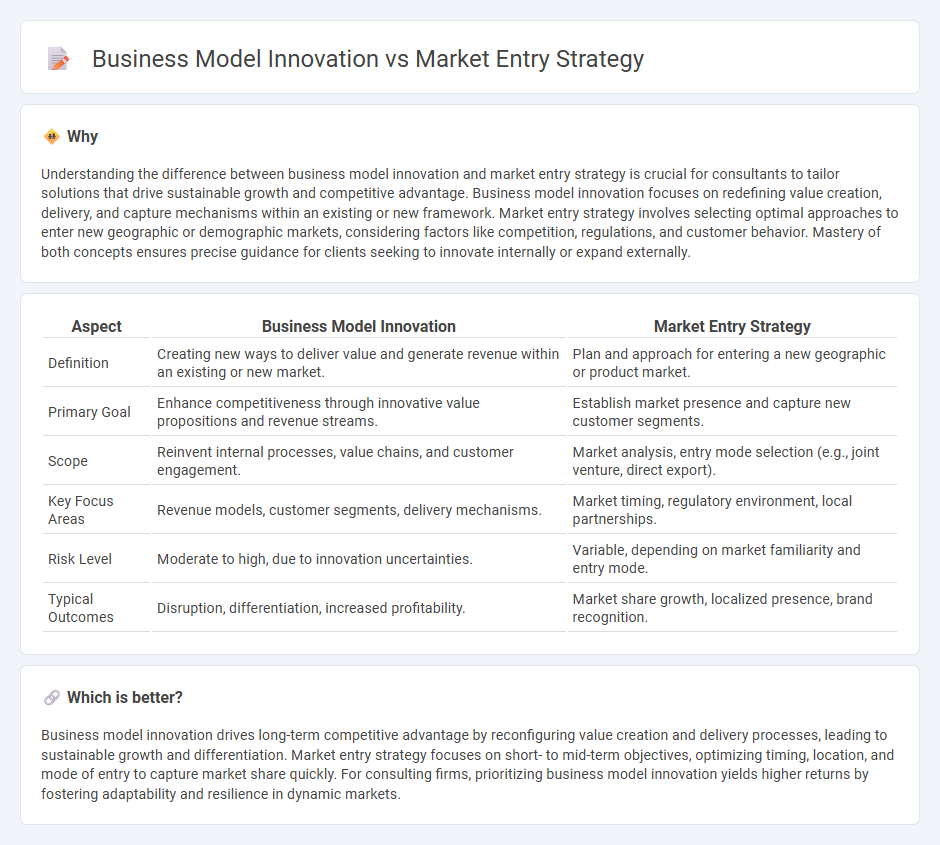
Business model innovation focuses on redefining how a company creates, delivers, and captures value to achieve sustainable competitive advantage and long-term growth. Market entry strategy targets identifying the optimal approach for entering new geographic or demographic markets, considering factors such as target audience, competition, and regulatory environment. Explore these strategies further to unlock new opportunities and drive your business success.
Why it is important
Understanding the difference between business model innovation and market entry strategy is crucial for consultants to tailor solutions that drive sustainable growth and competitive advantage. Business model innovation focuses on redefining value creation, delivery, and capture mechanisms within an existing or new framework. Market entry strategy involves selecting optimal approaches to enter new geographic or demographic markets, considering factors like competition, regulations, and customer behavior. Mastery of both concepts ensures precise guidance for clients seeking to innovate internally or expand externally.
Comparison Table
| Aspect | Business Model Innovation | Market Entry Strategy |
|---|---|---|
| Definition | Creating new ways to deliver value and generate revenue within an existing or new market. | Plan and approach for entering a new geographic or product market. |
| Primary Goal | Enhance competitiveness through innovative value propositions and revenue streams. | Establish market presence and capture new customer segments. |
| Scope | Reinvent internal processes, value chains, and customer engagement. | Market analysis, entry mode selection (e.g., joint venture, direct export). |
| Key Focus Areas | Revenue models, customer segments, delivery mechanisms. | Market timing, regulatory environment, local partnerships. |
| Risk Level | Moderate to high, due to innovation uncertainties. | Variable, depending on market familiarity and entry mode. |
| Typical Outcomes | Disruption, differentiation, increased profitability. | Market share growth, localized presence, brand recognition. |
Which is better?
Business model innovation drives long-term competitive advantage by reconfiguring value creation and delivery processes, leading to sustainable growth and differentiation. Market entry strategy focuses on short- to mid-term objectives, optimizing timing, location, and mode of entry to capture market share quickly. For consulting firms, prioritizing business model innovation yields higher returns by fostering adaptability and resilience in dynamic markets.
Connection
Business model innovation directly influences market entry strategy by redefining value propositions, revenue streams, and operational processes tailored to new target markets. Effective market entry strategies leverage innovative business models to gain competitive advantage, optimize resource allocation, and adapt to local customer needs. The synergy between these elements enhances scalability and sustainability, crucial for successful expansion in dynamic industries.
Key Terms
**Market Entry Strategy:**
Market entry strategy involves selecting the most effective approach to enter and establish a presence in a new market, considering factors such as target audience, competitive landscape, and local regulations. Successful market entry strategies leverage modes like joint ventures, franchising, or direct investment to optimize market penetration and minimize risks. Explore detailed insights on crafting tailored market entry strategies to enhance your global business success.
Market Analysis
Market entry strategy emphasizes identifying target markets, analyzing competitive landscapes, and assessing customer needs to optimize initial positioning and resource allocation. Business model innovation focuses on creating new value propositions, revenue streams, and operational frameworks that disrupt existing market paradigms. Explore our detailed insights to understand how market analysis drives both strategic approaches effectively.
Entry Modes
Market entry strategy focuses on selecting the optimal entry modes such as exporting, franchising, joint ventures, or wholly owned subsidiaries to penetrate new markets effectively. Business model innovation involves redesigning core value delivery mechanisms and revenue streams to gain competitive advantage, often requiring adaptation of entry modes for successful implementation. Explore in-depth insights on how entry mode choices influence both market entry effectiveness and business model innovation outcomes.
Source and External Links
What is a Market Entry Strategy? - A market entry strategy outlines steps, resources, and methods to access a new market, including common approaches like exporting, licensing, franchising, joint ventures, and direct investment.
Market entry strategy - This strategy plans distribution and delivery of goods/services to a new target market, influenced by factors like trade barriers, competition, and product lifecycle, with various entry modes including licensing, joint ventures, and exporting.
5 steps to create a winning market entry strategy - Creating a market entry strategy involves setting clear goals, researching the market, choosing an entry mode, considering financing, and executing the plan to successfully export or expand internationally.
 dowidth.com
dowidth.com